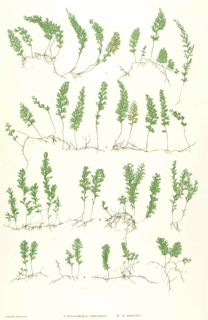
Spearmint, also known as garden mint, common mint, lamb mint and mackerel mint, is a species of mint, Mentha spicata, native to Europe and southern temperate Asia, extending from France in the west to southern China in the east. It is naturalized in many other temperate parts of the world, including northern and southern Africa, North America and South America. It is used as a flavouring in food and herbal teas. The aromatic oil, called oil of spearmint, is also used as a flavoring and sometimes as a scent.

Wright Aeronautical (1919–1929) was an American aircraft manufacturer headquartered in Paterson, New Jersey. It was the successor corporation to Wright-Martin. It built aircraft and was a supplier of aircraft engines to other builders in the golden age of aviation. Wright engines were used by Amelia Earhart and Charles Lindbergh. In 1929, the company merged with Curtiss Aeroplane and Motor Corporation to form Curtiss-Wright.

Chlorophytum comosum, usually called spider plant due to its spider like look, but also known as spider ivy, ribbon plant, and hen and chickens is a species of evergreen perennial flowering plant of the family Asparagaceae. It is native to tropical and southern Africa, but has become naturalized in other parts of the world, including western Australia. Chlorophytum comosum is easy to grow as a houseplant because of its resilience, but it can be sensitive to the fluoride in tap water, which commonly gives it "burnt tips". Variegated forms are the most popular.

Hibiscus tiliaceus, commonly known as the sea hibiscus or coast cottonwood, is a species of flowering tree in the mallow family, Malvaceae, with a pantropical distribution along coastlines. It has also been introduced to Florida and New Zealand. It has been debated whether this species is native or introduced to Hawaii.

Atriplex is a plant genus of about 250 species, known by the common names of saltbush and orache. It belongs to the subfamily Chenopodioideae of the family Amaranthaceae s.l.. The genus is quite variable and widely distributed. It includes many desert and seashore plants and halophytes, as well as plants of moist environments. The generic name originated in Latin and was applied by Pliny the Elder to the edible oraches. The name saltbush derives from the fact that the plants retain salt in their leaves; they are able to grow in areas affected by soil salination.

Anthericum is a genus of about 65 species, rhizomatous perennial plants in the family Asparagaceae, subfamily Agavoideae. It was formerly placed in its own family, Anthericeae. The species have rhizomatous or tuberous roots, long narrow leaves and branched stems carrying starry white flowers. The members of this genus occur mainly in the tropics and southern Africa and Madagascar, but are also represented in Europe.

Christopher Wright is an American professional wrestler, better known by his ring name, C.W. Anderson. He is best known for his appearances with Extreme Championship Wrestling from 1999 to 2001.

Chlorophytum, is a genus of almost 200 species of evergreen perennial flowering plants in the century plant subfamily within the asparagus family. The plants are native to the tropical and subtropical regions of Africa, Australia, and Asia.

Cocculus is a genus of 11 species of woody vines and shrubs, native to warm temperate to tropical regions of North America, Asia and Africa. The common name moonseed is also used for the closely related genus Menispermum.

Chlorophytum tuberosum is a species of flowering plant in the Asparagaceae family. It is one of several species known by the common name musli. It is native to parts of Africa and India. It has historical uses in Ayurveda.

Hymenophyllum is a genus of ferns in the family Hymenophyllaceae. Its name means "membranous leaf", referring to the very thin translucent tissue of the fronds, which gives rise to the common name filmy fern for this and other thin-leaved ferns. The leaves are generally only one cell thick and lack stomata, making them vulnerable to desiccation. Consequently, they are found only in very humid areas, such as in moist forests and among sheltered rocks. They are small and easy to overlook.

Scadoxus cyrtanthiflorus is a herbaceous plant endemic to the Rwenzori Mountains of east tropical Africa. Unusually for the genus Scadoxus its tubular blooms are pendant. It is sometimes grown as an ornamental plant in heated greenhouses.

Sinomenine or cocculine is an alkaloid found in the root of the climbing plant Sinomenium acutum which is native to Japan and China. The plant is traditionally used in herbal medicine in these countries for rheumatism and arthritis. However, its analgesic action against other kinds of pain is limited. Sinomenine is a morphinan derivative, related to opioids such as levorphanol and the non-opioid cough suppressant dextromethorphan. Its anti-rheumatic effects are thought to be primarily mediated via release of histamine, but other effects such as inhibition of prostaglandin, leukotriene and nitric oxide synthesis may also be involved.
Eucarpha is a genus of flowering plant of the family Proteaceae, endemic to New Caledonia. Two species are recognised. Up to 1975, these were classified within the genus Knightia until Lawrence Johnson and Barbara G. Briggs recognised their distinctness, particularly their prominent bracts, in their 1975 monograph "On the Proteaceae: the evolution and classification of a southern family". Nomenclatural combinations for these two species in the genus Eucarpha were published in 2022. Other sources, including Plants of the World Online as of April 2022, treat Eucarpha as a synonym of Knightia.

Scadoxus multiflorus is a bulbous plant native to most of sub-Saharan Africa from Senegal to Somalia to South Africa. It is also native to Arabian Peninsula and to the Seychelles. It is naturalized in Mexico and in the Chagos Archipelago.It is also found in Indian peninsula. It is grown as an ornamental plant for its brilliantly coloured flowers, either in containers or in the ground in where the climate is suitable. There are three recognized subspecies. Strongly toxic like other Scadoxus species, it has been used as a component of arrow poisons and fishing poisons, as well as in traditional medicine. Common names, some of which are used for other species, include blood lily, ball lily, fireball lily, blood flower, Katherine-wheel, oxtongue lily, poison root and powderpuff lily.

Cynanchum acutum is a species of climbing vine swallowworts native to Europe, Africa, and Asia.

Scadoxus membranaceus is a flowering plant in the Amaryllidaceae family. It is a bulbous plant from South Africa. The smallest of the species of Scadoxus, it is sometimes cultivated as an ornamental plant where a minimum temperature of 5 °C (41 °F) can be maintained.

Dipankar Borah is an Indian field botanist from Assam.

















